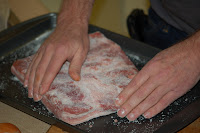 This year we are having three separate celebrations for Christmas. Tonight, Christmas Eve, we have our daughter Jessica and her fiance Darcy for dinner. They are spending Christmas Day with his family so we are reviving a tradition that my paternal Aunt enjoyed: the Christmas Eve feast.
This year we are having three separate celebrations for Christmas. Tonight, Christmas Eve, we have our daughter Jessica and her fiance Darcy for dinner. They are spending Christmas Day with his family so we are reviving a tradition that my paternal Aunt enjoyed: the Christmas Eve feast.Our celebration tonight will include a beautiful prime rib roast with roasted potatoes and root vegetables, but mostly it will be a celebration of a new commitment that was made right before my birthday. Not that this was a surprise, but it made me stop and think about life when Jess told me that they were engaged. I really don't think I am old enough to have a daughter her age, but DNA doesn't lie.
James is home from the big city and off visiting his old friends in the neighbourhood. He is spending the Eve and the Day in Victoria with family there so will be with us again on Boxing Day. I think the tradition of gorgeous leftovers will rule the day so not much planning to be done and lots of time for visiting.
So Christmas Day will be Gerry and I. First time ever we have been alone. But really, we won't be alone. We share that day with so many memories and so many loved ones that are no longer here that the house will be full.
The hustle of Christmas's past where little children waited breathlessly to see what Santa would bring are gone now until a crop of grandchildren arrive (and it should be a while really!) But in the meantime, I try to continue the traditions I grew up with. The turkey was taken out of the freezer yesterday to thaw slowly in the very cold garage. Turnips, carrots, and parsnips all wait their turn in the roaster. The dressing was long ago learned and will accompany the turkey. Cranberry sauce was made at Thanksgiving so it had time to age gracefully in its glass jars.
We will take some time to talk together, to plan our upcoming year. We are goal setters, so those will be mulled along with cider, both making the house an optimistic and comforting place. All in all, it will be the kind of celebration that seems so rooted in the short days and long evenings of our Canadian winter.
But mostly we will be grateful. Grateful for wonderful children, for great family, and lots and lots of amazing friends. We wish you all the very best of the Holiday and for 2012. Take time to reflect and to ponder and to just be glad that you are where you are.
Best wishes
Chris






































